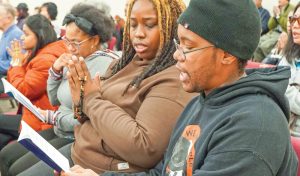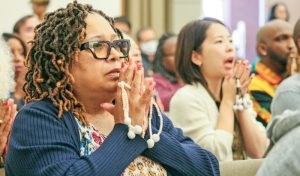When we revere Myoho-renge-kyo inherent in our own life as the object of devotion, the Buddha nature within us is summoned forth and manifested by our chanting of Nam-myoho-renge-kyo. This is what is meant by “Buddha.” To illustrate, when a caged bird sings, birds who are flying in the sky are thereby summoned and gather around, and when the birds flying in the sky gather around, the bird in the cage strives to get out. When with our mouths we chant the Mystic Law, our Buddha nature, being summoned, will invariably emerge. The Buddha nature of Brahma and Shakra, being called, will protect us, and the Buddha nature of the Buddhas and bodhisattvas, being summoned, will rejoice. This is what the Buddha meant when he said, “If one can uphold it [the Mystic Law] even for a short while I will surely rejoice and so will the other Buddhas.” (“How Those Initially Aspiring to the Way Can Attain Buddhahood through the Lotus Sutra,” The Writings of Nichiren Daishonin, vol. 1, p. 887)
The following are excerpts from SGI President Ikeda’s lecture “Learning From Nichiren’s Writings: The Teachings for Victory,” which appears in the new members study guide, An Introduction to Buddhism, edition 2, pp. 92–96.
Here, Nichiren Daishonin describes the great benefits of chanting Nam-myoho-renge-kyo, the single sound with which we can summon forth the Buddha nature of all living beings . . . He then proceeds to explain the process by which this great life state of Buddhahood manifests, employing the very accessible metaphor of a bird in a cage: “When a caged bird sings, birds who are flying in the sky are thereby summoned and gather around, and when the birds flying in the sky gather around, the bird in the cage strives to get out” (“Those Initially Aspiring to The Way,” WND-1, 887).
The “bird in the cage” represents the Buddha nature of us ordinary people. The cage represents a state of being shackled by fundamental darkness or ignorance, various deluded impulses or earthly desires, and all kinds of suffering. The “caged bird sings” refers to ordinary people rousing faith in the Mystic Law and chanting Nam-myoho-renge-kyo. The “birds who are flying in the sky,” meanwhile, represent the Buddha nature of all living beings. We call forth our Buddha nature—that is, the Myoho-renge-kyo within us—by chanting with our own voices.
At the same time, however, the sound of our chanting in fact also calls forth the Buddha nature of diverse living beings. This is because—as we saw in the earlier passage—Myoho-renge-kyo is also the name of the Buddha nature of all Buddhas, bodhisattvas, and other living beings in the Ten Worlds. Once we chant the Mystic Law, therefore, its power is such that it can call forth the Buddha nature of all of them. In other words, our voice chanting Nam-myoho-renge-kyo is the powerful sound that awakens and summons forth the Buddha nature of all living beings throughout the universe.
When the birds flying in the sky are called forth by the bird in the cage and gather around it, the bird in the cage tries to get out, says the Daishonin. The moment when the cage of ignorance and suffering disappears, we are liberated from all shackles of illusion, and can soar freely in the “sky of the essential nature of phenomena” (“On the Large Carriages Drawn by White Oxen,” WND-2, 976)—that is, the realm of enlightenment as vast and unimpeded as the heavens.
Earnest prayer in the form of chanting Nam-myoho-renge-kyo resonates with the Mystic Law that pervades the universe, envelops one’s own life and brings forth the power to break through one’s own inner darkness or ignorance. In other words, the act of chanting Nam-myoho-renge-kyo is a drama of profound communion or interaction between ourselves and the universe.
You are reading {{ meterCount }} of {{ meterMax }} free premium articles




